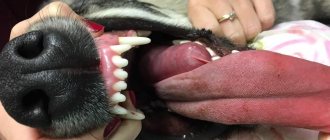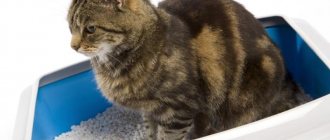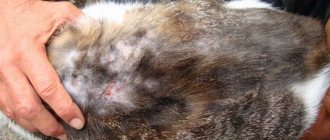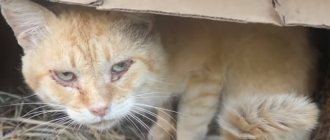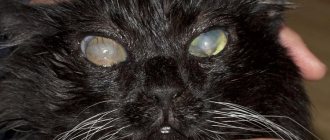Lymph nodes are part of the body's cleansing system, performing the function of drainage, filtering blood that has passed through the organs and tissues of the body. An equally important function of the lymph nodes is to contain the spread of infection, that is, if there were no lymph nodes, any infection that entered the animal’s blood would affect the entire body in one blood circulation cycle. Inflammation of the lymph nodes in cats is a secondary phenomenon and a symptom indicating the presence of an inflammatory process.
Functions of lymph nodes in a cat's body
Lymph nodes are an important part of the lymphatic system in the body of our smaller brothers. They are peripheral organs of the lymphatic system.
Functions of lymph nodes in a cat’s body:
- Protective. Lymph nodes are a kind of barrier that prevents foreign agents and bacteria from penetrating other organs and systems of the body.
- Conductive (homepoietic). Conducting lymph from tissues into the venous bed.
- Immune, activation of the immune response. Lymph nodes contain T- and B-lymphocytes - cellular structures that form immune defense.
Thus, the main function of lymph nodes is a biological filter. Lymph flows through them, which comes from the internal organs and systems of the body.
Depending on their location, lymph nodes are classified into: regional (submandibular, inguinal, occipital), superficial (located above the fascia) and deep (subfascial).
Inflammation of the lymph nodes behind the ear in a cat
Enlarged or inflamed lymph nodes in a dog (also known as lymphadenopathy or lymphadenitis) is a symptom that means the dog is suffering from some kind of disease or pathology.
Do not think that inflammation of these protective points can occur on its own. When the dog is healthy, lymph nodes are simply impossible to detect.
They swell and become inflamed only as a result of a disruption in the functioning of one of the main internal systems or an attack on the animal’s body.
The lymph nodes themselves are small, round-shaped structures that are located in many areas of the animal's body. They are an integral part of a separate lymphatic system responsible for supporting the animal's immunity.
Lymph nodes are designed to protect the pet's body by working as filters that contain lymphocytes (cells that destroy threats). If inflammation develops in a dog's body or an infection gets into it, the lymph nodes located close to the affected area react to it by releasing lymphocytes and increasing in size.
That is, the site of inflammation of the lymph node can give a signal about where exactly it is worth looking for the root cause that led to the occurrence of this symptom.
Inflammation of the lymph nodes can be acute. In such circumstances, formations with lymphocytes grow extremely rapidly. However, with chronic diseases, the lymph nodes may well increase in size gradually.
This symptom can be caused by almost any disease or pathology. Their list is really huge, but experts usually conditionally divide diseases that can provoke inflammation of the lymph nodes into large blocks, depending on which systems they affect.
Thus, we can distinguish several groups of diseases that lead to inflammation or swelling of one of the main defense systems of the body. Among them:
- Diseases of the respiratory system: lung carcinoma and bacterial pneumonia.
- Gastrointestinal diseases: ulcer. gastritis and other inflammatory diseases of the stomach, gum carcinoma, enteritis. pharyngitis, as well as oral melanoma and intestinal leimiosarcoma.
- Immune diseases: atopy and allergic pneumonia.
- Infectious diseases: Lyme disease, hemobartonellosis, blastomycosis, cryptococcosis, leptospirosis, nocardiosis, parvovirus enteritis. salmonellosis, tuberculosis. infectious hepatitis. as well as ehrlichiosis.
- Dermatological diseases: ear carcinoma, melanoma of the skin and toes, pyoderma. dermal hemangiosarcoma, pododermatitis.
- Diseases of the urinary system: carcinoma of the fingers, carcinoma of the urethra and bladder.
- Oncological diseases: oral cavity tumors, mast cell tumors, hemangiosarcoma of the spleen and liver.
- Diseases caused by parasitic infestation: sarcoptic mange, toxoplasmosis, strongyloidiasis.
- Diseases of the genital organs and reproductive system of the body: breast tumors, venereal tumors.
- Disease of the cardiovascular system: endocarditis.
- Diseases of the circulatory system: thrombocytopenia, leukemia, bone hemangiosarcoma, polymyositis, polyarthritis, anemia, dermatomyositis.
- Surgical diseases: peritonitis, pleural effusion, pyothorax, chylothorax.
We suggest you read: Why does a cat have white worms in her stool? What to do?
Based on the information presented above, we can conclude that it is simply impossible to diagnose the disease at home or carry out symptomatic treatment. If your pet has inflammation of the lymph nodes, you should take the animal to an experienced specialist as soon as possible, who, in turn, will carry out a number of necessary diagnostic measures.
Dog owners need to be aware that it is simply impossible to eliminate this clinical sign without treating the underlying disease.
Such treatment can only be carried out if the inflammation of these points is caused by some kind of mechanical damage, which can be caused, for example, by an overly tight collar.
In this case, the animal owner and the doctor only need to determine what exactly is harming the animal and completely eliminate this factor. However, such cases are quite rare, so most likely the dog will have to be treated for some very serious illness.
If the inflammation of the lymph nodes was caused by any infectious or viral disease, specialists usually prescribe the animal a course of antibiotics.
However, if the dog’s condition does not improve and the lymph nodes do not become smaller, this may indicate that the pet is suffering from lymphosarcoma.
In such cases, the specialist changes the course of treatment and prescribes hormonal therapy, conducts a special series of tests, and also recommends a course of chemotherapy.
However, if they do not produce results, and the process of suppuration does not stop, the veterinarian’s main task is to prevent further spread of the infection.
To do this, a specialist can open the abscess, clean it and install a special drainage.
What is lymphadenitis
Lymphadenitis is an inflammation of the tissues of the lymph nodes, which is accompanied by an increase in their size due to an increase in the number of lymphocytes and the migration of leukocytes into them. In animals, as in humans, the inflammatory process in the lymph nodes develops due to primary inflammation of a specific localization.
Important! In some cases, lymph nodes can become a source of infection if suppuration develops in them.
Causes of lymphadenitis in cats:
- acute, chronic viral, bacterial, parasitic infections;
- weakening of immunity, resistance;
- respiratory diseases (rhinitis, sinusitis, bronchitis, laryngotracheitis, sinusitis, tonsillitis);
- neoplasia (malignant tumors that metastasize to the lymph nodes);
- lymphoma (cancer of the lymph nodes);
- failure to comply with hygiene rules;
- autoimmune infections;
- herpes virus;
- mycoses;
- connective tissue diseases;
- allergic reactions, allergies of various etiologies;
- injuries, penetrating wounds through which pathogenic microorganisms penetrate tissues and internal organs.
Inflammation can be provoked by blood-sucking parasites (fleas, ticks, lice eaters), endoparasites (worms), while damage to the lymph nodes by the inflammatory process during parasitic infections is less common.
In general, lymphadenitis is a protective, defensive reaction of the body that is not life-threatening for the pet as long as the lymph is not affected.
Tip 1: How to treat swollen lymph nodes in a cat
It is important for a loving owner not only to caress the cat, but also to feel it for inflammation. Behind the thick fur, you can notice the appearance of bumps and enlarged organs. Especially if the general condition of the animal does not raise any questions. Treatment of inflamed lymph nodes in a cat requires care.
Causes and symptoms of inflammation of the lymph nodes
The term lymphadenopathy is used to refer to inflamed lymph nodes. Inflammation can occur due to infection and cancer.
If problems with the lymph nodes are due to infection, then this is a disease called lymphadenitis. When inflammation begins in the body, the lymph nodes adjacent to the affected organ often become enlarged. For example, if a cat’s gums are affected, then the submandibular lymph nodes and tonsils usually become enlarged.
If the animal’s lymph nodes are massively enlarged, then you need to donate blood. With leukosarcoma and leukemia, there may be such symptoms, but without tests these diseases are not recognized in any way.
Other symptoms depend on the organ or part of the body in which the disease develops. With a sore throat, your cat may be reluctant to eat, cough, and drool. Some of these signs may be due to swollen lymph nodes because they interfere with swallowing.
If a cat's paws are infected, there will be an increase in lymph nodes along the animal's paws. Lameness may occur. Moreover, the reason for this will not be so much pain in the limbs themselves, but rather a painful reaction of the inflamed lymph nodes.
Lymphadenitis is generally not dangerous for cats. Naturally, subject to timely detection and treatment. When the disease is cured, the lymph nodes return to their normal state.
Treatment of lymphadenitis in cats
It is possible to choose effective treatment only by accurately establishing the causes
Source
Symptoms and first signs of inflammation
The main sign of lymphadenitis in cats is an increase in the size of one or more lymph nodes and their pain. Acute pain occurs due to rapid overstretching of the node capsule.
Symptoms and first signs of inflammation:
- increase in size of lymph nodes;
- pain on palpation and examination;
- sudden increase in temperature;
- change in behavior;
- depression, apathy, anxiety;
- sluggish reaction to stimuli;
- pallor, anemic mucous membranes;
- loss, decreased appetite;
- drowsiness, weakness;
- swelling of tissues at the site of localization of the lesion, inflammation;
- faded wool;
- rapid pulse, palpitations;
- discharge from the eyes, nose;
- increased thirst;
- weight loss;
- swelling in the area of development of inflammation and damage.
Important! Lymphadenitis may not be accompanied by acute pain. It all depends on the root cause of development. Acute pain upon palpation of the node may indicate the active stage of the disease.
When palpated, the cat experiences pain and discomfort. Both general and local temperatures rise. Animals often experience itching. A small red rash and blisters filled with clear liquid appear on the body. Lymph nodes become elastic. They can grow to the size of a small pea.
Lymphadenitis often affects the lymphatic vessels. Lymphangitis and acute intoxication develop.
If oncology is suspected, the affected nodes have a bumpy surface and a dense structure. Lymph nodes are enlarged unequally in size. The node affected by the tumor grows faster than the other. Temperature is within normal limits. Until the appearance of metastases and the transition of neoplasia to the final stages, the cat leads a normal lifestyle.
The nature of inflammation of the lymph nodes and its causes
Lymphadenopathy is a collective concept indicating an enlargement of one or more lymph nodes. Further, the disease is divided by reason of occurrence:
- Viral or bacterial infection (lymphadenitis).
- Malignant neoplasm (oncology).
With an infectious lesion, there is an increase in the lymph nodes, which are located closest to the source of inflammation. For example, if a cat has pulpitis (purulent inflammation of the dental canal), the submandibular nodes swell. The “rage” of infection is accompanied by an increase in body temperature and other “standard” symptoms of the inflammatory process.
Warning! Don’t “paint” gloomy pictures when thinking about oncology. Yes, pets are susceptible to incurable diseases, but an enlarged lymph node is not a guarantee of cancer.
To dispel gloomy suspicions, we note the main symptoms indicating a normal, harmless and non-fatal enlargement of the lymph nodes:
- When palpated, you can find that the nodes are smooth.
- Typically, the increase affects 2 parallel nodes, but their growth may not be symmetrical.
- Depending on the location of the inflammation, accompanying symptoms are observed - sore throat, lameness.
- Against the general background, weakness and poor appetite are observed with normal drinking regimen.
Features of inflammation depending on location
Clinical manifestations depend on where the lesion is located. Let us consider the features of inflammation depending on the localization of pathological processes.
On the front and hind legs
If there is an inflammatory process on the front and hind legs, in addition to weakness, lethargy, and high temperature, lameness, stiff gait, discomfort due to increased tension in the muscle structures, and pain when walking are noted.
The axillary, supraclavicular, ulnar lymph nodes, and inguinal nodes are affected during inflammation of the hind limbs. Causes: infections, injuries.
Damage to the lymph nodes in the neck
The lymph nodes in the neck become inflamed due to viral or bacterial infections, or when eating low-quality, stale meat. Noted for toxoplasmosis, respiratory infections (rhinitis, tracheitis, bronchotracheitis, laryngotracheitis, sinusitis, tonsillitis).
The nodes are painful and greatly enlarged. The animal is lethargic, apathetic, and refuses food. Depression gives way to anxiety. A white coating is noticeable on the tongue. An unpleasant odor emanates from the mouth.
Submandibular lymph nodes, on the cheeks
Submandibular nodes and lymph nodes on the cheeks become inflamed due to viral and bacterial infections, dental diseases (stomatitis, gingivitis), injuries to the oral mucosa, and penetration of pathogenic agents into regional lymph nodes. Located under the angular rounding of the jaw near the salivary glands, in the cheek area (lymph nodes on the cheeks).
Cats have difficulty eating and drinking water. The oral mucosa is hyperemic and edematous. The temperature is increased by 1-2 degrees from normal. Loss of appetite causes your cat to lose weight.
In the groin, on the stomach
Inflammation of the lymph nodes in the groin and abdomen is a fairly commonly diagnosed form of lymphadenitis in cats. The nodes filter lymph coming from organs located in the peritoneum, groin, and genitals.
The inguinal nodes in cats are located on the inside of the hind limbs. Due to the fat layer, they are quite difficult to palpate, even if they are enlarged.
Inguinal lymphadenitis is caused by:
- viral, bacterial infections;
- inflammatory processes in the pelvis;
- oncology;
- diseases of the genitourinary tract;
- poisoning with toxins;
- diseases of the gastrointestinal tract of inflammatory nature;
- wounds, injuries of the peritoneum, genitals.
A sick pet is lethargic, constantly sleeps, takes unnatural positions, looks for secluded cool places, and refuses food. The temperature is unstable, increased by 1-2 degrees from normal. Urination is painful and difficult. In females, swelling and tenderness of the mammary glands are noted. In the area of inflammation, foci of extensive damage to nearby tissues are noted. The formation of purulent foci and abscesses is possible.
In the armpits
The axillary lymph nodes are located under the armpit of the front legs. Lymphadenitis of the axillary nodes can be triggered by allergic reactions, inflammatory processes, furunculosis, viral infections, and colds.
When the lymph nodes in the armpits are inflamed, the animal experiences discomfort, pain, and difficulty walking. The cat is inactive, lethargic, and constantly sleeps. The nodes are painful and enlarged.
In the ears
If the lymph nodes in the ears are inflamed, most often the pathology is caused by inflammatory processes localized in the inner, middle ear. The cause may be viral, respiratory infections, injuries, tumors in the ears, and dental diseases.
In addition to the increase in inflamed nodes, pain, high temperature and swelling in the ear area are noted. The cat shakes its ears and behaves restlessly.
Symptoms of lymphadenitis in cats and methods of treatment
Lymphadenopathy is a collective concept indicating an enlargement of one or more lymph nodes. Further, the disease is divided by reason of occurrence:
- Malignant neoplasm (oncology).
Warning! Don't paint gloomy pictures when thinking about oncology. Yes, pets are susceptible to incurable diseases, but an enlarged lymph node is not a guarantee of cancer.
To dispel gloomy suspicions, we note the main symptoms indicating a normal, harmless and non-fatal enlargement of the lymph nodes:
- When palpated, you can find that the nodes are smooth.
- Typically, the increase affects 2 parallel nodes, but their growth may not be symmetrical.
- Depending on the location of the inflammation, accompanying symptoms are observed - sore throat, lameness.
- Against the general background, weakness and poor appetite are observed with normal drinking regimen.
Oncology is suspected if:
- There is rapid growth of one of the lymph nodes.
- When palpated, the surface of the tumor is lumpy.
- The animal does not experience an increase in temperature. At first, the cat behaves as usual, not paying attention to the neoplasm.
- Courses of stimulant drugs and immunostimulants.
- At an early stage - surgical intervention - complete surgical excision of the tumor.
Important! No surgeon can guarantee whether there will be a relapse during surgical excision of a malignant tumor.
It is possible to carry out the initial diagnosis yourself; it is enough to know the location of the lymph nodes; a photo and description will help you:
- Submandibular - located under the angular rounding of the jaw.
- Popliteal - located on the hind leg, easily palpable on the back side of the knee.
- Axillary - located in each armpit of the front legs. Unlike the human structure, they are slightly extended towards the head.
- Inguinal – located under a small layer of fat, on the abdomen, in the area of the inner thigh. To make it easier to navigate, find the lower mammary glands (males have them too) and move along an inclined path towards the tail and paw.
Important! If you observe a massive enlargement of the lymph nodes, you need to contact a veterinarian; the symptom may indicate two serious diseases - leukemia or leukosarcoma.
Note! Inflammation of the lymph nodes is a defensive reaction that is not life-threatening for the pet. The disease that causes damage to the lymph is dangerous.
Persian cats: a touch of woolly soul
Vaginitis in dogs is a threat to women's health
Wolfdog of Saarloos: handsome, but arrogant
Lymph nodes in the body of a furry pet perform cleansing and protective functions. With their help, blood fluid that has managed to pass through all the pet’s organs is filtered, and infectious agents are also contained. That is, if they were not in the cat’s body, then infection would occur in one circle of blood circulation.
Inflammation of the lymph nodes in cats is not an independent disease, but is only a symptom that inflammatory processes have begun within the body. The article will discuss in detail the causes of enlarged lymph nodes, as well as the symptoms and treatment of a similar phenomenon in a cat.
Experts call enlarged lymph nodes lymphadenopathy. However, this is a general, “collective” concept that must be differentiated based on the cause leading to the manifestation of the pathological phenomenon. Thus, doctors distinguish two variants of the disease, which are characterized by enlarged lymph nodes. They differ in their etiology and traditionally include:
- Lymphadenitis: the peculiarity of the disease is that it involves the entry of various viruses and bacteria into the cat’s body, causing its lymph nodes to increase in size.
- Cancer: malignant tumors that arise in the pet’s body can metastasize, which causes inflammation of the lymph nodes in the cat. First of all, this applies to the lymph node whose location is closest to the area of the body affected by cancer.
It is important to understand that the location of the focus where the inflammatory process occurs plays a key role in the manifestations of both lymphadenitis and cancerous tumors.
So, if the dental canal is affected, then the cat’s tonsils and submandibular nodes will swell, and if the inflammation affects the paws, then the lymph nodes along the pet’s limbs become vulnerable.
The owner should know that lymphadenitis is not as dangerous as oncology, since it is quite simple to treat, and, in case of successful therapy, the nodes quickly return to normal size.
The diagnosis depends entirely on the reasons why the lymph node is enlarged. In the case of lymphadenitis in a cat, the nodes undergo such characteristic changes as:
- the affected lymph nodes are hot to the touch compared to other parts of the body;
- The disease always affects two nodes parallel to each other, and their increase is not symmetrical;
- with an inflammatory process in the lymph nodes that are located in the neck, the main symptom is a sore throat in the pet;
- the cat’s appetite decreases, against the background of this, thirst increases, the animal is able to absorb huge amounts of water;
- the pet becomes apathetic, prefers to lie in one place, and reacts sluggishly to the owner’s attempts to cheer him up.
For oncological pathologies, the symptoms are somewhat different; they include:
- intense increase in the size of one lymph node;
- the resulting neoplasm is not so smooth as in the case of lymphadenitis, but rather ribbed or lumpy;
- In the initial stages of the disease, the cat’s behavior does not change, and the resulting tumor does not bother him in any way.
If the inflammatory foci are in the axillary or inguinal lymph nodes, then the pet begins to limp. An attentive owner can detect the presence of health problems in a cat by simply palpating its body. If alarming symptoms are detected, the pet should be immediately taken to an appointment with a veterinarian.
Experienced breeders of purebred cats advise beginners to clearly understand the location of lymph nodes on the body of pets. For this purpose, the following reminder has been created, with which you can easily determine which nodes were exposed to malicious influence. Let's look at them in more detail:
- Submandibular nodes: dislocated and easily palpable under the cat’s lower jaw.
- Inguinal: located under a thin layer of fat on the inner thigh. Their palpation will be greatly facilitated by the scheme in which their detection is carried out through the location of the cat’s mammary glands and a gradual, smooth movement from them, along an inclined line, to the cat’s tail or hind limbs.
- Popliteal: located under the animal’s hind legs, palpable on the back of the knee.
- Axillary: you need to look for them in the armpits of the forelimbs, usually they are slightly shifted towards the head.
- Elbow nodes: located directly next to the shoulders of the front legs.
We suggest you read: How to clean a cat's ears step by step instructions
It is important to know that if in a short time all the lymph nodes on the body are swollen in a representative of the feline family, then these are serious symptoms of diseases such as leukosarcoma or leukemia.
Under any circumstances, owners should not limit the diagnosis to a home examination, but rather take the cat to a veterinary hospital, where he will have a blood test, palpation of the affected areas of the body, and also examined using ultrasound, x-rays and biopsy.
Treatment of the disease
If the etiology of the disease is infectious, treatment at home is acceptable, but in order to avoid complications, it is advisable to additionally consult with a specialist. Particular attention should be paid to the general condition of the cat, its appetite and the process of defecation.
At first, you don’t have to treat the animal at all, giving the immune system the opportunity to cope with the problem on its own. If the lymph nodes continue to increase rapidly, and the cat’s body temperature is elevated, then you should seek qualified help.
Using a biochemical blood test, the doctor will try to determine the actual cause of the inflammation and then prescribe the correct drug therapy. It is carried out comprehensively, including antibiotic and antifungal drugs, as well as vitamins, to maintain the body’s defense systems.
In some cases, the veterinarian may insist on a biopsy from the lymph node. Unfortunately, medicine has not yet come up with a single and effective treatment for oncology.
It all depends on the extent of the damage and how quickly the cancer was detected.
The therapeutic regimen includes chemotherapy and surgery, as well as taking hormonal drugs and immune stimulants.
It should be said right away that the risk of a fatal outcome is very high, about 85%. However, no specialist will give a 100% guarantee that after all phases of treatment there will be no relapse. If the neoplasm has metastasized throughout the cat’s body, then euthanasia is recommended so as not to prolong the pet’s suffering.
Finally, I would like to say that lymphadenopathy is a rather dangerous pathological condition that can develop in both a kitten and an adult.
It may indicate that the cat has both fairly treatable lymphadenitis and a terrible cancerous tumor.
The owner should closely monitor the health of their pet and regularly feel it for enlarged lymph nodes. If such a symptom is detected, you should not waste time and take the cat to see a doctor.
Lymph nodes play an important role in the human and animal body. They are part of the body’s cleansing system and act as a kind of filter for blood, which has already passed through all the tissues and organs.
The second important function of lymph nodes is to contain infection. That is, if they were not there, any virus that entered the body would infect it in just one blood circulation cycle.
Inflammation of the lymph nodes in cats is a symptom of some kind of inflammatory process taking place in the body.
Lymphadenopathy is a general term that refers to enlarged lymph nodes.
Inflammation of the lymph nodes is called lymphadenopathy.
The disease is distinguished by the reason for its occurrence:
- Lymphadenitis. Suggests a viral or bacterial infection.
- Oncology. Indicates the presence of malignant neoplasms.
Forms of lymphadenitis
Lymphadenitis in pets occurs predominantly in an acute form, less often in a chronic form, each of which has its own causes of development and symptoms.
Forms of lymphadenitis by reason and nature:
- viral, bacterial;
- traumatic;
- catarrhal;
- fibrinous;
- hemorrhagic;
- purulent;
- cancer (malignant tumors);
- nonspecific, which is caused by a decrease in the immune potential of the body after infections or damage to the skin.
Important! The most life-threatening form of lymphadenitis for cats is the purulent form. If treatment is not started, the pus melts the capsule of the node, leading to the formation of an encapsulated abscess. Sepsis may develop, which can be fatal.
Distinctive features of outpatient treatment
If a lymph node in the neck becomes inflamed, seemingly for no apparent reason and without pain, you should immediately seek help and advice from highly qualified specialists. The fact is that during an examination of the inflamed lymph nodes in the neck, an oncological disease may be detected, which was the reason for the change in their size. As soon as the first symptoms of the disease are detected, immediate intervention by qualified doctors is required. In other cases, when symptoms indicate the presence of a chronic inflammatory process, therapeutic measures can be carried out without hospitalization by staying at home.
Having discovered a change in the size (increase) of the protective organs located on the neck, many patients seek to get rid of inflammation of the lymph nodes by treatment with folk remedies. Taking effective infusions and decoctions made from medicinal herbs and plants helps not only to successfully fight the disease, but also with the help of medicinal compositions prepared at home you can:
- stop the development of the inflammatory process;
- relieve swelling;
- get rid of pain;
- strengthen the body, increasing its level of resistance.
The first condition for successful treatment for inflammation of the lymph nodes in the neck at home is the refusal to use warm compresses. Secondly, do not use self-selected antibacterial drugs. Use only proven and well-known traditional medicine. Treatment at home should be carried out under the supervision of the attending physician and in accordance with his recommendations.
The presence of lymphadenitis forces the patient to refuse long walks in the fresh air, especially in cloudy weather, to constantly monitor the temperature, and to use protective bandages on the throat that protect the inflamed lymph nodes on the neck (both on the front and back surfaces).
Lymph nodes usually become inflamed when there are a large number of pathogenic microorganisms in the human body, but the disease can be dealt with through outpatient treatment at home. For this purpose, honey, tinctures of medicinal herbs made with vodka, ointments, rubs, and lotions are used.
Regardless of the patient’s age and despite the fact that traditionally therapy for lymphadenitis is carried out in a hospital, a positive result in the treatment of inflammation of the lymph nodes in the neck can be achieved by applying aloe or Kalanchoe leaves to the skin in the area of the enlarged lymph node. To achieve this goal, it is necessary to use not only products prepared from medicinal herbs and plants. While at home, the patient takes pills and mixtures, immunomodulatory and anti-inflammatory drugs, which are part of the drug treatment.
First aid at home
Lymphadenitis, regardless of the form and nature of the course, cannot be ignored due to the development of possible complications.
First aid at home is aimed at improving and normalizing the general condition of the pet. It is impossible to recommend specific treatment methods, since lymphadenitis is most often a consequence of various pathologies and diseases.
The choice of drugs for general and local therapy depends on the cause. Cold compresses and anti-inflammatory medications will help relieve inflammation. To eliminate pain, analgesics are given.
Treatment of the disease
If the etiology of the disease is infectious, treatment at home is acceptable, but in order to avoid complications, it is advisable to additionally consult with a specialist. Particular attention should be paid to the general condition of the cat, its appetite and the process of defecation. At first, you don’t have to treat the animal at all, giving the immune system the opportunity to cope with the problem on its own. If the lymph nodes continue to increase rapidly, and the cat’s body temperature is elevated, then you should seek qualified help.
Using a biochemical blood test, the doctor will try to determine the actual cause of the inflammation and then prescribe the correct drug therapy. It is carried out comprehensively, including antibiotic and antifungal drugs, as well as vitamins, to maintain the body’s defense systems.
In some cases, the veterinarian may insist on a biopsy from the lymph node. Unfortunately, medicine has not yet come up with a single and effective treatment for oncology. It all depends on the extent of the damage and how quickly the cancer was detected. The therapeutic regimen includes chemotherapy and surgery, as well as taking hormonal drugs and immune stimulants.
It should be said right away that the risk of a fatal outcome is very high, about 85%. However, no specialist will give a 100% guarantee that after all phases of treatment there will be no relapse. If the neoplasm has metastasized throughout the cat’s body, then euthanasia is recommended so as not to prolong the pet’s suffering.
Finally, I would like to say that lymphadenopathy is a rather dangerous pathological condition that can develop in both a kitten and an adult. It may indicate that the cat has both fairly treatable lymphadenitis and a terrible cancerous tumor. The owner should closely monitor the health of their pet and regularly feel it for enlarged lymph nodes. If such a symptom is detected, you should not waste time and take the cat to see a doctor.
Treatment regimen
The treatment regimen for cats when diagnosing lymphadenitis, as already noted, completely depends on the cause. In most cases, complex therapy is prescribed. Complex antibiotics are used for local and general treatment, anti-inflammatory, hormonal agents, analgesics, sulfonamides, and antifungal medications. In addition to drug treatment, physiotherapeutic techniques are used.
To maintain protective forces and increase resistance, the veterinarian prescribes complex vitamin and mineral preparations and immunoprotectors.
When diagnosing oncology, surgery is performed if there are no contraindications. A course of chemotherapy, hormones, immunostimulants, alternative medicine (herbal decoctions), and probiotics are prescribed.
Diagnostics
If lymphadenitis is suspected, a thorough history taking, examination with palpation of all superficial lymph nodes, general and biochemical blood tests are carried out.
Sometimes additional diagnostic tests are required: abdominal ultrasound, radiography, lymph node biopsy, bacteriological, virological or mycological examination.
Treatment should be aimed at eliminating the cause of lymphadenitis. So, with inflammation of the submandibular lymph nodes, treatment of diseases of the oral cavity (gingivitis, stomatitis, abscesses, diseased teeth) is usually required.
If a systemic infection is detected, antibiotics and antifungal drugs are prescribed.
In case of purulent inflammation of the lymph node, surgical treatment may be required: opening and drainage of the abscess.
Enlargement of lymph nodes can occur not only with inflammation, but also with cancer (lymphoma, metastases). Only a veterinarian can establish a diagnosis and prescribe adequate treatment.
Drugs and antibiotics used
Medicines, frequency of administration, dosages are prescribed and prescribed by the attending veterinarian, having in hand the results of diagnostic studies.
Drugs and antibiotics used:
- Fosprenil;
- Brovaseptol;
- Sinulox;
- Azidin-vet;
- Interferon;
- Amiksin;
- Metronidazole;
- Amoxicillin;
- Combikel;
- Tsiprovet.
To relieve local inflammation, with pustules and abscesses, ointments and linemints that have an anti-inflammatory effect (Vishnevsky ointment, ichthyol) are used.
Diagnostic methods
In this situation, the animal may be referred by a doctor for an ultrasound procedure to identify the cause of the symptoms. Enlargement of the submandibular and other lymph nodes in cats requires urgent contact with a veterinary clinic. A specialist in swollen lymph nodes determines where the pathological foci are located, assesses the degree of the disorder and collects a detailed history. Treatment is selected after determining the cause of enlarged lymph nodes in a cat. For this purpose, the following diagnostic procedures are carried out:
- ultrasound examination of problem organs;
- x-rays;
- laboratory testing of urine and blood;
- stool analysis, which is used to detect worms in cats.
When an animal has an inflamed lymph node and there is a suspicion of the development of oncology, a biopsy of the damaged tissue is additionally prescribed with further histological examination.
Prevention measures
Prevention, proper, proper care of the cat will prevent lymphadenitis and reduce the risk of the pet contracting dangerous viral-bacterial and parasitic diseases.
Prevention measures:
- Timely vaccination, revaccination;
- Balanced diet;
- Reducing contact with street animals;
- Strengthening the immune system with vitamins and mineral complexes with a natural diet.
- Systematic inspection.
- Timely treatment of inflammatory processes, systemic, viral, bacterial diseases;
- Treatment against ecto-endoparasites.
